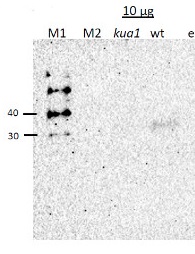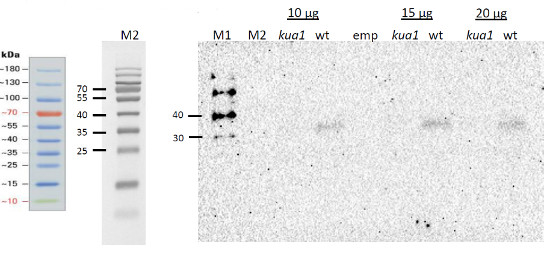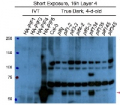1

KUA1 | MYB transcription factor
AS15 2989 | Clonality: Polyclonal | Host: Rabbit | Reactivity: Arabidopsis thaliana
- Product Info
-
Immunogen: KLH-conjugated peptide derived from Arabidopsis thaliana KUA1 protein sequence, UniProt: Q9LVS0,
TAIR:AT5G47390 .The peptide used to elicit this antibody is also conserved in MYB1R1 of Triticum urartu UniProt:M7YW99 and MYBS3 of Oryza sativa subsp. japonica, UniProt: Q7XC57-2Host: Rabbit Clonality: Polyclonal Purity: Serum Format: Lyophilized Quantity: 50 �l Reconstitution: For reconstitution add 50 �l of sterile water Storage: Store lyophilized/reconstituted at -20�C; once reconstituted make aliquots to avoid repeated freeze-thaw cycles. Please remember to spin the tubes briefly prior to opening them to avoid any losses that might occur from material adhering to the cap or sides of the tube. Tested applications: Western blot (WB) Recommended dilution: 1 : 5000 (WB) Expected | apparent MW: 39,6 kDa - Reactivity
-
Confirmed reactivity: Arabidopsis thaliana, Beta vulgaris Predicted reactivity: Capsicum annuum, Cephalotus follicularis, Cicer arietinum, Glycine max, Glycine soja, Gossypium arboretum, Cucumis melo, Medicago truncatula, Nelumbo nucifera, Nicotiana tabacum, Nicotiana sylvestris, Theobroma cacao, Vigna radiata var. radiata
Species of your interest not listed? Contact usNot reactive in: No confirmed exceptions from predicted reactivity are currently known - Application Examples
-
Application example
10-20 µg of total protein from fresh Arabidopsis thaliana leaves was grinded and extracted in 10 mM Tris/HCL pH 7,5; 50 mM NaCl; 0,5 mM EDTA, 1% Triton X-100 supplemented with protease inhibitor cocktail (Sigma, P9599). After 15 minutes of incubation on ice the extracts were centrifuged at 6000g for 5 minutes at 4 degrees. The supernatant was mixed with 2X Laemli buffer and denatured at 96°C for 5 min. After cooling down, the samples were separated on 12 % SDS-PAGE gel and blotted to PVDF in 9 minutes using a Pierce G2 Fast Blotter in transfer buffer. Blots were blocked with 5% blocking solution (containing non-fat milk protein in TBS) for 1h at room temperature (RT) with agitation. Blot was incubated in the primary antibody at a dilution of 1: 5000 overnight in 5% blocking solution. The antibody solution was decanted and the blot was rinsed briefly twice, then washed twice for 10 min with TBS-T and twice for 10 min in 5% blocking solution at RT with agitation. Blot was incubated in secondary antibody (anti-rabbit IgG horse radish peroxidase conjugated, from Agrisera AS09 602) diluted to 1:10 000 in 5% blocking solution for 90 minutes at RT with agitation. The blot was washed four times in TBS-T for 10 minutes as described above and developed using chemiluminescent detection reagent. Blots were imaged using a BioRad Chemidoc system using an exposure time of 300 seconds.
Courtesy Dr. Jozefus Schippers, University of Aachen, Germany - Additional Information
-
Additional information (application): The antibody was used in tissue printing on German sugar beet and was found in vascular bundles - Background
-
Background: KUA1 (MYB transcription factor) involved in regulation of hypocotyl elongation in response to darkness by enhancing auxin accumulation in a phytochrome-interacting factor (PIF) proteins-dependent manner. Promotes lateral roots formation and place a critical role in in developmentally regulated and dark-induced onset of leaf senescence by repressing the transcription of several genes involved in chloroplast function and responses to light and auxin. Promotes responses to auxin, abscisic acid (ABA), and ethylene. Alternative names: Myb-related protein H, AtMYBH, AtMYBS3, MYBS3-homolg protein, Protein KUODA1.
- Product Citations
-
Selected references: Pandey et al. (2019). Epigenetic control of UV-B-induced flavonoid accumulation in Artemisia annua L. Planta. 2019 Feb;249(2):497-514. doi: 10.1007/s00425-018-3022-7.
- Protocols
-
Agrisera Western Blot protocol and video tutorials
Protocols to work with plant and algal protein extracts - Reviews:
-
This product doesn't have any reviews.



